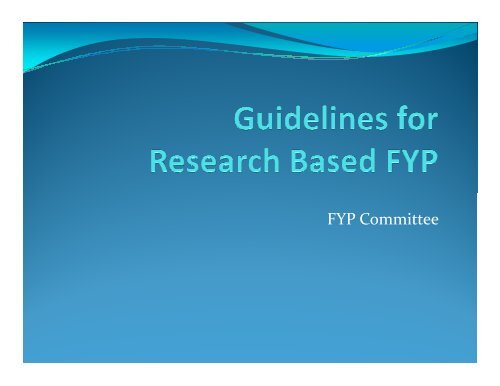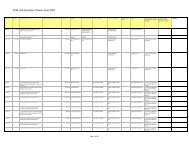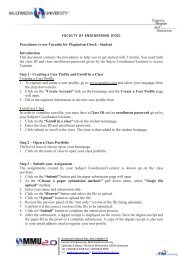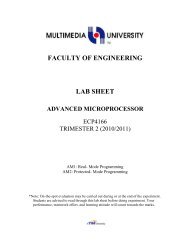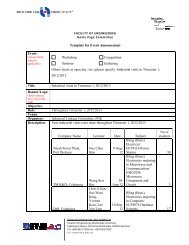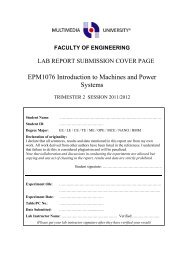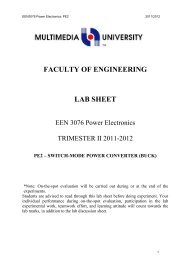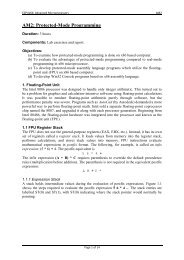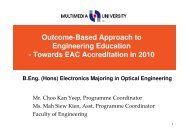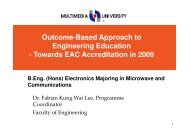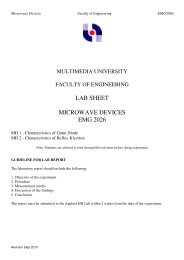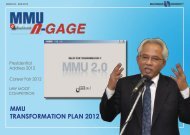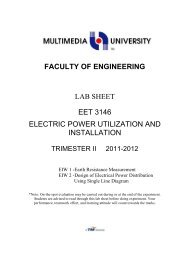Research Based FYP Guideline
Research Based FYP Guideline
Research Based FYP Guideline
Create successful ePaper yourself
Turn your PDF publications into a flip-book with our unique Google optimized e-Paper software.
<strong>FYP</strong> Committee
Content<br />
Background<br />
<strong>Research</strong> based <strong>FYP</strong> <strong>Guideline</strong>s<br />
<strong>FYP</strong> Report
Background<br />
Requirements from Engineering Accreditation Council<br />
(EAC) Malaysia:<br />
An investigative research oriented approach to engineering<br />
studies.<br />
A requirement of the programme to include a significant<br />
project in its later stages.<br />
Individual analysis and judgement, capable of being assessed<br />
independently.<br />
Develop techniques in literature review and information<br />
processing, as necessary with all research approaches.<br />
Provide opportunities to utilise appropriate modern<br />
technology in some aspects of the work, emphasising the<br />
need for engineers to make use of computers and multimedia<br />
technology in everyday practice.
<strong>Research</strong> <strong>Based</strong> <strong>FYP</strong> <strong>Guideline</strong>s<br />
1. To conduct a focused literature review<br />
To understand the problem.<br />
To study previous related work<br />
Recent literature (
<strong>Research</strong> <strong>Based</strong> <strong>FYP</strong> <strong>Guideline</strong>s<br />
3. To implement the solution or carry out the<br />
investigation<br />
4. To evaluate the implementation or analyse the<br />
collected data with detail analysis and discussions<br />
To compare with previous or known results<br />
5. To conclude the investigation<br />
6. To recommend future work
<strong>FYP</strong> Report General Requirements<br />
The standard <strong>FYP</strong> report format is strictly followed (refer to the detail<br />
<strong>FYP</strong> Report <strong>Guideline</strong>s).<br />
The <strong>FYP</strong> report has been verified against plagiarism via Turnitin, that<br />
the report is original with proper citations.<br />
The <strong>FYP</strong> report is easy to read with a sound logical structure. All<br />
aspects of the project are properly documented in the report.<br />
Writing is technically sound. Technical terms are properly used and not<br />
excessive.<br />
From the abstract, readers are able to tell what are investigated and the<br />
findings.<br />
From the conclusion, readers are able to tell what are the major<br />
achievements of the project.<br />
All figures are crystal clear.<br />
No of pages: typically about 50 pages
<strong>FYP</strong> Report Outline<br />
Introduction<br />
Theoretical Background or Review of Literature<br />
Method of Investigation or Details of Design<br />
Presentation of Data and Discussions on Findings<br />
Conclusions and Recommendations<br />
References
Introduction<br />
Motivation (Why do this <strong>FYP</strong>?)<br />
Project scope and objectives (Problem statement)<br />
Report outline
Theoretical Background or Review of Literature<br />
Details of previous research work and findings<br />
Knowledge gaps<br />
Use citations, e.g. [4].<br />
Must follow the standard citation format described in<br />
Must follow the standard citation format described in<br />
the detail <strong>FYP</strong> report guidelines.
Method of Investigation or Details of Design<br />
Empirical research<br />
The measurement setup, calibration and measurement<br />
procedures, etc.<br />
Constructive research<br />
The construct, e.g. theory, algorithm, model,<br />
hardware/software, etc.<br />
The experimental setup and procedures to evaluate the<br />
construct performance.
Presentation of Data and Discussions on Findings<br />
Compare data with previous or known results if available.<br />
Present and compare data using graphs, charts, tables, etc.<br />
Explain ALL presented data and comparisons.<br />
Draw and explain the implications of the data and<br />
comparisons.<br />
For example, if there are discrepancies between the<br />
theoretical and experimental results, an analysis or discussion<br />
should follow to explain the possible cause or source of error.
Conclusions and Recommendations<br />
Summarize the work done.<br />
Highlight the main contributions of the work and its<br />
significance and constraints.<br />
Do not add new information (e.g. results that were not<br />
reported earlier).<br />
Discuss the implications or potential applications of<br />
the results.<br />
Recommend possible future work.
References<br />
Follow the format


